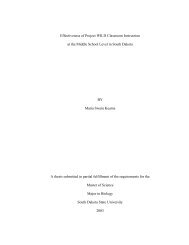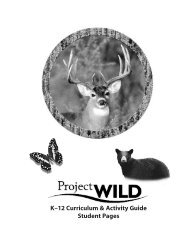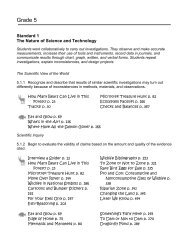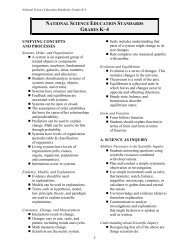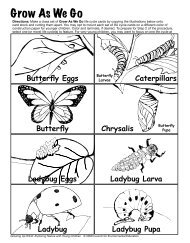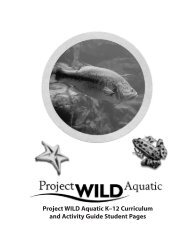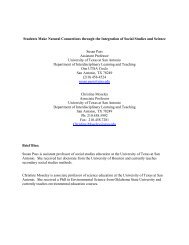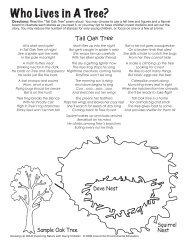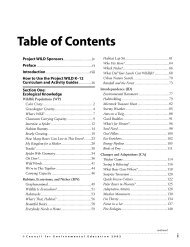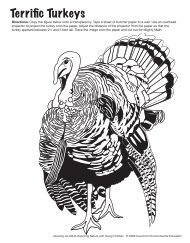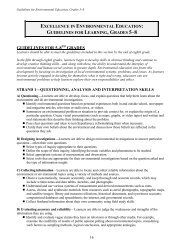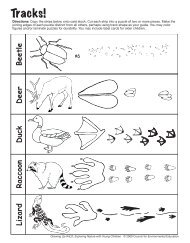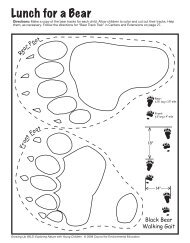Conceptual Framework [PDF] - Project Wild
Conceptual Framework [PDF] - Project Wild
Conceptual Framework [PDF] - Project Wild
Create successful ePaper yourself
Turn your PDF publications into a flip-book with our unique Google optimized e-Paper software.
<strong>Conceptual</strong> <strong>Framework</strong><br />
This framework serves as the conceptual basis for activities in the <strong>Project</strong> WILD and <strong>Project</strong> WILD<br />
Aquatic K–12 Curriculum and Activity Guides. Every concept statement in a topic area is directly<br />
addressed by the activities listed for that topic. Activities under other topics may also support the concepts<br />
directly or indirectly.<br />
Ecological Knowledge<br />
<strong>Wild</strong>life Populations (WP)<br />
I. Characteristics<br />
A. <strong>Wild</strong>life comprises all nonhuman and nondomesticated animals. <strong>Wild</strong>life includes but is not<br />
limited to insects, spiders, birds, reptiles, fish, amphibians, and mammals.<br />
1. <strong>Wild</strong>life is all around, although it may not be seen or heard or its presence otherwise sensed.<br />
2. <strong>Wild</strong>life varies from forms that are microscopic to those more than 100 feet in length,<br />
and it occurs in a variety of forms, colors, and shapes.<br />
B. All living things go through a series of orderly changes in life cycles. Some species have distinct<br />
changes; the young of other species resemble their parents.<br />
C. Living things all need food, water, shelter, and a suitable place to live.<br />
D. Animals can be classified according to life needs, behavior, and physical characteristics, including<br />
body appearance, movement, habitat type, and relationship to humans (wild/domesticated).<br />
II. Population Dynamics<br />
A. <strong>Wild</strong>life numbers and species compositions are not static but are constantly changing.<br />
1. Systematic inventory of wildlife populations did not become a common practice until<br />
the 1930s, although journals of early explorers reflect considerable variation in historic<br />
population levels.<br />
2. Some wildlife populations exhibit cyclic patterns over time.<br />
a. Living things tend to reproduce in numbers greater than their habitat can support.<br />
(1) Carrying capacity is the dynamic equilibrium expressed by the availability of habitat<br />
components and the number of animals the habitat can support.<br />
(2) Each area of land or water, and ultimately the planet, has a carrying capacity of plants<br />
and animals.<br />
(a) Carrying capacity is determined by climatic, geological, biological, or behavioral<br />
factors, along with human activities.<br />
(b) Carrying capacity may fluctuate from season to season and year to year.<br />
(c) Carrying capacity affects and is affected by wildlife behavior.<br />
458 ....................................................................................................<br />
P r o j e c t W I L D K – 1 2 C u r r i c u l u m a n d A c t i v i t y G u i d e
A p p e n d i c e s<br />
........................................................................................................<br />
C o n c e p t u a l F r a m e w o r k<br />
i. The numbers, health, and distribution of wildlife are related to carrying capacity.<br />
ii. Carrying capacity limitations can result in competition between and among<br />
domestic animals, wildlife, and humans.<br />
b. A population tends to increase in size until limited by one or more factors.<br />
(1) When one or more limiting factors exceed the tolerance range for an animal,<br />
population, or species, it directly affects the well-being of the animal(s) and may<br />
result in death or extinction.<br />
(2) Limiting factors include life history parameters such as food, water, shelter, space,<br />
disease, predation, and climatic conditions, as well as human activities such as<br />
development, pollution, and hunting.<br />
B. Natural laws are ultimately as binding on human populations as on wildlife.<br />
Habitats, Ecosystems, and Niches (HN)<br />
I. Distribution<br />
A. <strong>Wild</strong>life is present in nearly all areas of the Earth.<br />
B. Each environment has characteristic life forms.<br />
1. The environment—created and shaped by natural forces or modified by humans—<br />
shapes life forms that occupy it.<br />
2. Each species occupies a niche within the range of environments in which it is found.<br />
II. Importance<br />
A. Good habitat is the key to the survival of humans and wildlife.<br />
1. Habitat is composed of many integrated components including food, water, shelter or cover,<br />
space, and the suitable arrangement of these in relation to each other.<br />
2. In addition to supporting wildlife, ecosystems must furnish the products humans need<br />
to survive.<br />
B. <strong>Wild</strong>life may be used as an indicator of the environmental health of an ecosystem.<br />
Interdependence (ID)<br />
I. Commonalities<br />
A. All living elements of an ecological system are interdependent.<br />
1. All forms of life depend on food, water, shelter, and space in a suitable arrangement.<br />
2. Humans and wildlife have similar basic needs.<br />
a. Humans and wildlife share environments and are subject to essentially the same<br />
environmental conditions.<br />
b. The health and well-being of humans and wildlife depend on the quality of the<br />
natural environment.<br />
B. Plants and animals in ecological systems live in a web of interdependence, in which each<br />
species contributes to the functioning of the overall system.<br />
continued<br />
....................................................................................................<br />
© C o u n c i l f o r E n v i r o n m e n t a l E d u c a t i o n 2 0 0 3 459
A p p e n d i c e s<br />
........................................................................................................<br />
C o n c e p t u a l F r a m e w o r k<br />
II. Interactions<br />
A. All living things are affected by and interact with their environments.<br />
B. In a naturally functioning ecosystem, life forms and environmental factors interact to keep wildlife<br />
populations in long-term dynamic equilibrium with each other and with their habitats.<br />
1. Many interactions result in a flow of energy and matter throughout the system.<br />
a. Energy takes a one-way course through an ecosystem and dissipates at every trophic level.<br />
b. Material substances, such as water, nitrogen, carbon, and phosphorus, cycle through<br />
ecosystems.<br />
2. Food webs illustrate the interrelationships of all living things.<br />
a. Either directly or indirectly, plants support nearly all forms of animal life,<br />
including humans.<br />
(1) Energy from the sun and organic matter enters the animal world through herbivores,<br />
those animals that eat plants.<br />
(2) A relatively large quantity of plant material is required to support herbivores<br />
(primary consumers), and herbivores can support only a smaller number of carnivores<br />
(secondary consumers).<br />
(3) Decomposers complete the cycle by breaking down organic matter formed by<br />
photosynthesis.<br />
b. Trophic relationships in an ecosystem may be complex and may vary depending on<br />
environmental conditions.<br />
C. <strong>Wild</strong>life interacts with other wildlife and thereby affects the functioning of the ecological system.<br />
1. Interactions exist between different populations.<br />
a. Competition is a major determinant of community structure.<br />
b. Predation can be beneficial or harmful to a population as a whole.<br />
c. Symbiotic relationships may benefit or harm one or both of the partners.<br />
2. Interactions exist among members within a population, including competition<br />
and cooperation.<br />
Changes and Adaptations (CA)<br />
I. Environmental Changes<br />
A. Variation and change occur in all ecological systems.<br />
B. Succession is an orderly, gradual, and continuous replacement of one natural community of<br />
life by another.<br />
1. Succession influences what kinds of plants and animals live in an area.<br />
a. New communities arise when ecosystems change through succession.<br />
b. Newer communities may have less diversity.<br />
c. Species present in new communities will have traits that allow them to survive in<br />
the new environment.<br />
d. Over time, species diversity may increase in a new community.<br />
2. Natural events and human activities affect the rate and direction of succession.<br />
C. All forms of life are affected by changes in the quality, quantity, and distribution of their habitats.<br />
460 ....................................................................................................<br />
P r o j e c t W I L D K – 1 2 C u r r i c u l u m a n d A c t i v i t y G u i d e
A p p e n d i c e s<br />
........................................................................................................<br />
C o n c e p t u a l F r a m e w o r k<br />
II. Organism Adaptations<br />
A. All life forms exhibit adaptations to the environments in which they live.<br />
1. Fish and wildlife are adapted to their environment in ways that enable them to survive<br />
and maintain their populations.<br />
a. Many physical and behavioral adaptations, such as body coverings, hibernation, and<br />
migration, are associated with climatic conditions.<br />
b. Adaptations to predator and prey relationships may include behavioral (e.g., signaling,<br />
flight, freezing) as well as physical (e.g., camouflage, mimicry) variations.<br />
c. Reproductive strategies are adaptations that maximize species survival.<br />
2. Fish and wildlife species differ in their ability to adapt to changes in their habitats.<br />
B. Each habitat is suitable only to those life forms that are adapted to its ecological conditions.<br />
C. Isolated ecosystems are more vulnerable to environmental change.<br />
Biodiversity (BD)<br />
I. Types<br />
Biodiversity can refer to a variety of natural systems, a variety of species in an area, or a genetic<br />
diversity within a species.<br />
A. Ecosystem Diversity<br />
1. Ecosystem diversity is affected by many influences, such as climate and level of disturbance.<br />
2. Ecosystems undergo successional changes that are usually gradual.<br />
3. Species that are not able to adapt to ecosystem change may become extinct.<br />
4. A biologically healthy ecosystem is diverse over the range of the ecosystem, not necessarily<br />
within each community.<br />
B. Species Diversity<br />
1. Climate and habitats influence species diversity.<br />
2. Organisms that are not able to adjust to ecosystem changes will die.<br />
3. New ecosystems and ecosystems that are harsh tend to have relatively few species.<br />
4. Species diversity tends to be higher in the transition zone between ecosystems.<br />
C. Genetic Diversity<br />
1. Genetic variability is important to health within a species.<br />
2. Diversity facilitates adaptation to change and provides sources of new genetic material.<br />
II. Human Influence<br />
A. Some wildlife species are not native but have been introduced to the area they presently occupy.<br />
Such introductions can be beneficial, harmful, or both to other species in the ecosystem.<br />
B. Adding or subtracting members from a community affects other members of the community.<br />
C. Human activities can affect the rate at which wildlife becomes threatened, endangered,<br />
or extinct.<br />
continued<br />
....................................................................................................<br />
© C o u n c i l f o r E n v i r o n m e n t a l E d u c a t i o n 2 0 0 3 461
A p p e n d i c e s<br />
........................................................................................................<br />
C o n c e p t u a l F r a m e w o r k<br />
III. The Importance of Habitat<br />
A. Habitat is the key to wildlife survival.<br />
B. Improving habitat improves wildlife populations.<br />
C. Reintroduction of wildlife into its former range may be possible if suitable habitat and suitable<br />
wild stock are available, and if such other conditions as weather and predator levels do not<br />
substantially interfere.<br />
D. Management of one species will affect other species in a community.<br />
E. For a wildlife population to sustain itself, there must be suitable habitat to support a viable<br />
breeding population, not just a few individuals.<br />
Social and Political Knowledge<br />
Cultural Perspectives (CP)<br />
I. Cultural Development<br />
A. Human cultures and societies, past and present, affect and are affected by wildlife and its habitat.<br />
B. Values, ethics, and historical traditions of cultures and societies are reflected in their treatment of<br />
wildlife and other resources.<br />
1. Human and wildlife relationships are expressed through legends, myths, religious teachings<br />
and writings, symbols, protocols, ceremonies, and other cultural and societal activities.<br />
2. Appreciation of wildlife is often portrayed through creative expression of human relationships<br />
with wildlife in historic and contemporary times.<br />
II. Appreciation<br />
Societies and cultures within societies may have different attitudes toward wildlife and its uses,<br />
formed and transmitted by family, community, and other social groups in a variety of ways.<br />
A. The aesthetic and spiritual values that humans place on wildlife vary from person to person<br />
and culture to culture.<br />
B. Different cultures may disagree over certain uses of and rights to wildlife and its habitat.<br />
C. <strong>Wild</strong>life and its habitat are interpreted and treated differently by people viewing them from<br />
various cultural perspectives and frames of reference.<br />
1. Increasing separation of people from direct contact with the natural world has influenced<br />
human actions and attitudes toward wildlife. Therefore, actions and attitudes toward wildlife<br />
may be positive, negative, naïve, or misguided.<br />
2. Formal and nonformal education and the media shape the attitude of people toward wildlife<br />
and its habitat.<br />
Economic, Commercial, and Recreational Considerations (EC)<br />
I. Economic Considerations<br />
A. Natural resources include water, air, minerals, soil, fossil fuels, and plant life, as well as aquatic<br />
and terrestrial wildlife.<br />
1. Nonrenewable natural resources are those available on a finite basis.<br />
2. Renewable natural resources, including wildlife, can replenish themselves independently or<br />
with human assistance.<br />
462 ....................................................................................................<br />
P r o j e c t W I L D K – 1 2 C u r r i c u l u m a n d A c t i v i t y G u i d e
A p p e n d i c e s<br />
........................................................................................................<br />
C o n c e p t u a l F r a m e w o r k<br />
B. The distribution and abundance of wildlife can affect the economy of an area.<br />
1. Some wildlife provides products of commercial value or subsistence needs to humans.<br />
2. Members of some cultures still depend on wildlife to supply a portion of their requirements<br />
for food, shelter, and clothing.<br />
3. Human use of wildlife directly and indirectly creates job opportunities for people.<br />
C. Economic trends, in addition to increased human population and mobility, have important<br />
influences on wildlife and its habitat.<br />
D. The human culture and economic condition of an area affect and are affected by the available<br />
resources, including wildlife and its habitat.<br />
II. Commercial, Recreational, and Other Economic Considerations<br />
A. Historically, when conflict between recreational and commercial harvest of a wildlife species<br />
became severe, the commercial use had been eliminated.<br />
B. Recreational trends affect wildlife and its habitat.<br />
1. <strong>Wild</strong>life-based recreation is of major importance to many millions of North Americans.<br />
a. Consumptive wildlife-based activities, such as hunting and fishing, provide U.S. and<br />
Canadian citizens with millions of days of outdoor recreation each year.<br />
b. Nonconsumptive activities, such as wildlife photography, painting, feeding, and observation,<br />
also provide millions of days of recreation annually.<br />
2. More leisure time and the growing popularity of outdoor activities are increasing the pressures<br />
on wildlife and habitat.<br />
C. Funds provided by consumptive users, not general tax dollars, historically have been the primary<br />
source of income for most state wildlife management programs and some federal programs.<br />
1. Charging an access fee to hunt, fish, camp, play, or trap on private land is common.<br />
2. Reductions in income from direct consumptive uses of wildlife (hunting, fishing, etc.) and<br />
nonconsumptive uses (camping, bird watching, etc.) have resulted in a loss of revenue for<br />
natural resource agencies.<br />
Historical and Geographic Development (HG)<br />
I. Development of Society<br />
Historically, wildlife affected the development, movement, and size of human societies.<br />
A. Human societies and cultures developed in various ways, partly because environmental factors<br />
produced different types of plants and animals in different places.<br />
B. <strong>Wild</strong>life has played a significant role in the development of human culture through its influence<br />
on art, religion, and commerce.<br />
C. <strong>Wild</strong>life questions and issues have influenced alliances and conflicts between and within<br />
communities, societies, states, and nations.<br />
continued<br />
....................................................................................................<br />
© C o u n c i l f o r E n v i r o n m e n t a l E d u c a t i o n 2 0 0 3 463
A p p e n d i c e s<br />
........................................................................................................<br />
C o n c e p t u a l F r a m e w o r k<br />
II. Development of Commerce<br />
Throughout history humans have used wildlife for food, shelter, clothing, and other products.<br />
A. All livestock and pet animals were domesticated and developed from wildlife species as humans<br />
sought to provide themselves with food, shelter, medicines, and companionship, and to satisfy<br />
other needs or wants.<br />
B. The ways in which humans value wildlife and natural resources have changed over time.<br />
C. As human populations have grown and pressures on wildlife populations have increased, people<br />
have developed systems to study wildlife and to regulate human impact on wildlife and habitats.<br />
Political and Legislative <strong>Framework</strong>s (PL)<br />
I. United States<br />
A. Political trends affect wildlife and other natural resources.<br />
B. In the United States, wildlife is considered to be a public resource. Ownership of land or<br />
water alone does not secure ownership of wildlife on that land or in that water as it does in<br />
some other countries.<br />
1. Public decisions that affect wildlife and the environment are made through social and<br />
political processes designed to represent the wishes of the society.<br />
2. Primary responsibility for most wildlife conservation programs in the United States is<br />
delegated to governmental agencies.<br />
a. States are considered to have a greater responsibility for wildlife conservation programs<br />
than does the federal government. State wildlife agencies are legally responsible for<br />
managing most wildlife on public and private lands within their geographic jurisdictions.<br />
b. Federal agencies, in cooperation with state agencies, are legally responsible for managing<br />
wildlife affecting national interest, such as most threatened and endangered species and<br />
migratory wildlife.<br />
3. Nongovernmental institutions play significant roles in influencing environmental policy<br />
and direction.<br />
a. <strong>Wild</strong>life interest groups use judicial, legislative, and regulatory systems in reaching<br />
their objectives.<br />
b. Private organizations, industrial interests, and individual citizens also conduct wildlife<br />
conservation activities.<br />
C. Societies develop programs and policies relating to wildlife and its habitat through a<br />
variety of social mechanisms.<br />
II. International<br />
A. Other nations and governments have different policies and philosophies relating to wildlife<br />
ownership and protection and to habitat management.<br />
B. Many wildlife species regularly move across national boundaries, necessitating the adoption<br />
of international agreements and the formation of international agencies and organizations to<br />
ensure protection and management of these species.<br />
464 ....................................................................................................<br />
P r o j e c t W I L D K – 1 2 C u r r i c u l u m a n d A c t i v i t y G u i d e
A p p e n d i c e s<br />
........................................................................................................<br />
C o n c e p t u a l F r a m e w o r k<br />
Sustaining Fish and <strong>Wild</strong>life Resources<br />
Attitudes and Awareness (AA)<br />
I. Awareness<br />
A. Humans may find peace and inspiration through study and observation of wildlife, or simply<br />
through knowledge of its existence.<br />
B. Citizens benefit from experiencing and enjoying their natural resources.<br />
II. Values<br />
A. <strong>Wild</strong>life has intrinsic value, although humans often recognize only values based upon human<br />
wants and needs.<br />
1. The value placed on wildlife is commonly an issue in resource management decisions<br />
because value is often intangible and varies from person to person.<br />
2. Various groups interested in wildlife represent a wide range of philosophies and ethics<br />
concerning wildlife and how best to ensure its long range health and viability.<br />
B. Ecosystems have a finite capacity to provide for wildlife and human needs and wants.<br />
Sustainable living requires humans to live within the limits of the ecosystem capacity.<br />
Human Impacts (HI)<br />
I. The Importance of Impacts<br />
A. Human effects on fish and wildlife and their habitats are a driving force affecting environmental<br />
quality worldwide.<br />
B. The presence of people affects wildlife in positive and negative ways.<br />
II. Impacts<br />
A. Humans have the capacity to sustain themselves and wildlife.<br />
1. Although all organisms affect their environment, only humans have the capacity to consider<br />
the effects of their actions and to develop a community that is sustainable into the future.<br />
2. A sustainable community is one that is in balance with a healthy environment and perpetuates<br />
a healthy environment for future generations.<br />
3. The development and adoption of sustainable human lifestyles and social decisions can change<br />
the negative effects of human activity on wildlife.<br />
a. Individual lifestyle decisions including recreational choices, transportation options, housing<br />
selections, vocation, food, clothing, and energy use affect wildlife directly and indirectly.<br />
b. Community conservation practices, plus social, cultural, and economic values affect<br />
environmental programs and activities.<br />
B. Human populations and technologies often require space and activities that are detrimental<br />
to wildlife and its habitat.<br />
1. Human development encroaches on wildlife habitat, decreasing the amount of<br />
available habitat.<br />
2. <strong>Wild</strong>life habitats are being fragmented by urban sprawl, resulting in restricted<br />
wildlife movement.<br />
3. Some habitats are being altered by human development activities such as water<br />
storage and landscaping.<br />
continued<br />
....................................................................................................<br />
© C o u n c i l f o r E n v i r o n m e n t a l E d u c a t i o n 2 0 0 3 465
A p p e n d i c e s<br />
........................................................................................................<br />
C o n c e p t u a l F r a m e w o r k<br />
4. Contaminants and their bio-accumulative risks to both wildlife and humans threaten<br />
sustainable environments.<br />
5. Pollutants fall into a number of categories including acid rain, terrestrial runoff, biological<br />
(exotics, disease, waste), industrial waste and spills, post-consumer petroleum products,<br />
sewage, silt or sediment, thermal pollution, and radioactive and solid waste. Each of these<br />
pollutants creates particular effects on habitats and, if severe enough, may cause habitat loss.<br />
C. Loss and degradation of habitat are considered the greatest problems facing wildlife today.<br />
1. <strong>Wild</strong>life habitat loss because of natural trends or human activities is a condition common<br />
in nearly all nations.<br />
2. One specific cause of habitat degradation is pollutants, which can negatively affect<br />
environmental quality.<br />
3. Many critical habitats have been, and are, under pressure from historic and current<br />
development. Many have been damaged or lost.<br />
4. Remaining critical habitats can be, and in some cases are being, protected and maintained;<br />
damaged habitats can be, and in some cases are being, rehabilitated.<br />
Issues and Trends (IT)<br />
I. Global Perspectives<br />
A. Current wildlife issues and trends are complex, involve alternatives, and affect the environment.<br />
B. Many problems, issues, and trends involving wildlife in other parts of the world are similar<br />
to those in this country.<br />
1. <strong>Wild</strong>life issues can affect global and international as well as national, regional, and local<br />
political activities—particularly regarding human harvesting practices, transmission of<br />
pollutants and their secondary impacts, migratory species, and aquatic habitats.<br />
2. Consumptive uses of wildlife have been excessive in some settings and continue as a<br />
persistent problems in other parts of the world.<br />
3. Commercial sale of wildlife and wildlife products is controversial and has worldwide<br />
implications.<br />
II. <strong>Wild</strong>life Populations<br />
A. Human activities increasingly determine which species of plants and animals will flourish and<br />
which will decline or disappear.<br />
1. Most species that are endangered or threatened became so from natural or human-caused<br />
changes in their habitat and their inability to adapt or adjust to such changes.<br />
2. Exotic species introduced into a community can change the functioning of that system.<br />
a. Evaluation of the impact of non-native plants and animals on ecosystems is important to<br />
the management and conservation of those ecosystems.<br />
b. Citizens must be aware of their potential role in the dispersal of non-native species and the<br />
transmission of disease, and must take steps to avoid contributing to these problems.<br />
B. Private landowners play an important role in sustaining and improving wildlife habitat.<br />
466 ....................................................................................................<br />
P r o j e c t W I L D K – 1 2 C u r r i c u l u m a n d A c t i v i t y G u i d e
A p p e n d i c e s<br />
........................................................................................................<br />
C o n c e p t u a l F r a m e w o r k<br />
III. Land Use<br />
A. As human populations increase and become significantly urban, land usage is altered dramatically.<br />
1. Individual transportation systems that allow increased accessibility spearhead development<br />
and drive land-use changes.<br />
2. Natural areas are being converted to agricultural, recreational, residential, and commercial<br />
purposes.<br />
3. Fragmentation of biological communities, caused by human activities, affects wildlife diversity<br />
and populations.<br />
B. Consumer changes lead to agricultural production changes.<br />
IV. Human Perspectives<br />
A. <strong>Wild</strong>life issues involve conflicts between different interest groups.<br />
B. Issues involving wildlife and its habitat are often products of cultural differences and priorities.<br />
C. Well-informed individuals can assist resource management through increased involvement.<br />
V. Consumptive and Nonconsumptive Uses<br />
A. Conflicts exist within and between consumptive and nonconsumptive resource users.<br />
Any resolution must consider the needs of all groups and the sustainability of the resource.<br />
1. Whether uses of wildlife should be consumptive or nonconsumptive is of concern to many<br />
people.<br />
2. Among consumptive groups, conflicts often involve how, when, and how much wildlife<br />
populations are used.<br />
B. Nongame species have begun to receive greater and more specific management attention.<br />
<strong>Wild</strong>life Management (WM)<br />
I. Basic Concepts<br />
A. For management purposes, wildlife often has been divided into categories, including game,<br />
nongame, endangered, and threatened.<br />
1. Game species are those that are hunted, fished, or trapped for recreational or economic<br />
purposes by humans.<br />
2. Nongame species are those that are not hunted, fished, or trapped for either recreational<br />
or economic purposes by humans.<br />
3. Endangered species are those in danger of extinction throughout all or a significant portion<br />
of their ranges.<br />
4. Threatened species are those likely to become endangered.<br />
B. <strong>Wild</strong>life management is the application of scientific knowledge and technical skills to the<br />
protection, preservation, conservation, limitation, or enhancement of wildlife and its habitat.<br />
C. Conservation is the use of natural resources in a way that assumes their continuing availability<br />
to future generations through the wise use or protection of natural resources.<br />
continued<br />
....................................................................................................<br />
© C o u n c i l f o r E n v i r o n m e n t a l E d u c a t i o n 2 0 0 3 467
A p p e n d i c e s<br />
........................................................................................................<br />
C o n c e p t u a l F r a m e w o r k<br />
II. Management Considerations<br />
A. <strong>Wild</strong>life resources can be managed and conserved.<br />
B. <strong>Wild</strong>life species are important components of a larger ecosystem and should be managed within<br />
the context of that ecosystem.<br />
1. Management of one species of wildlife may have positive or negative consequences for other<br />
species within the same ecosystem.<br />
2. Management of aquatic wildlife and its habitat is directly influenced by land-based activities<br />
in the surrounding watershed.<br />
C. <strong>Wild</strong>life management considers the needs and desires of people as well as wildlife.<br />
1. Humans differ in how they value wildlife and its habitat, and the total demand on each<br />
may exceed the supply.<br />
2. <strong>Wild</strong>life management decisions must consider political, social, economic, and biological<br />
concerns; such decisions should involve all interested or potentially affected constituencies.<br />
3. These same factors may limit the scope and effectiveness of wildlife management activities.<br />
D. Philosophies and practices in wildlife management have been both supported and criticized by<br />
individuals, as well as by public and private organizations.<br />
E. Most wildlife exists on land or in waters that are not directly controlled by state or federal wildlife<br />
management agencies.<br />
III. Management Practices<br />
<strong>Wild</strong>life managers combine an understanding of species biology and of ecosystem structure and function<br />
with population- and land-manipulation techniques to accomplish management goals.<br />
A. <strong>Wild</strong>life management is based on natural sciences such as biology, ecology, geography, and soil<br />
science, as well as on many other disciplines.<br />
1. <strong>Wild</strong>life management practices have been developed through extensive research on<br />
ecosystems, through both observation and experimentation.<br />
2. Habitat management practices are often intended to mimic the effects of natural ecosystem<br />
processes, especially disturbance.<br />
B. <strong>Wild</strong>life management practices involve population and habitat inventory and monitoring,<br />
direct management of wildlife species through manipulation of populations, indirect management<br />
of wildlife species through protection and manipulation of habitat, and public regulation and<br />
education.<br />
1. Surveys of wildlife populations and their habitat provide important baseline information to<br />
guide management decisions.<br />
2. <strong>Wild</strong>life populations are manipulated through practices such as artificial propagation, stocking,<br />
transplanting, predator and damage control, and regulated harvest.<br />
3. Acquisition, protection, improvement, and restoration of habitat are considered to be the most<br />
successful and cost-effective long-range techniques for managing wildlife species.<br />
468 ....................................................................................................<br />
P r o j e c t W I L D K – 1 2 C u r r i c u l u m a n d A c t i v i t y G u i d e
A p p e n d i c e s<br />
........................................................................................................<br />
C o n c e p t u a l F r a m e w o r k<br />
4. Regulations are necessary for wildlife conservation, but they cannot substitute for the<br />
availability of suitable habitat, nor can they maintain the population of a species whose<br />
habitat has been depleted or destroyed.<br />
5. A public that is well educated about wildlife management issues is critical to the long-term<br />
success of wildlife management programs.<br />
C. Scientific knowledge of all aspects of wildlife, including biological and social, is growing.<br />
1. Technology changes affect environmental management decisions by allowing more<br />
sophisticated science-based analysis.<br />
2. <strong>Wild</strong>life agencies employ persons with a variety of scientific training and vocational skills.<br />
Responsible Action (RA)<br />
I. All plants and animals (human and wildlife) must live within the limits of their natural resources.<br />
A. Both consumptive and nonconsumptive resource uses by people can strengthen their sense of<br />
responsibility toward the environment and encourage ethical actions.<br />
B. It is the responsibility of citizens, government, and industry to avoid waste and destructive<br />
exploitation of natural resources, including wildlife.<br />
C. Communities can learn to live in a sustainable manner by understanding the effects of their<br />
actions on the long-term health of the environment.<br />
1. Citizens must understand their rights, privileges, and responsibilities, plus the consequences<br />
of their actions. That is, they should be aware of methods to help protect and improve the<br />
resource and should have the opportunity to practice and apply them.<br />
2. Private decisions that affect wildlife and the environment are made through personal<br />
judgments. Each person makes such decisions each day, including use of time and energy,<br />
consumer choices, and vocational and leisure time activities.<br />
3. Citizens can become involved in the management of wildlife, habitat, and the environment<br />
by direct participation in the political process or through local, state, national, or international<br />
organizations.<br />
4. Individuals can influence public processes by voting, demonstrating, lobbying, seeking office,<br />
and supporting compatible interest groups.<br />
5. All users of wildlife must respect the rights and property of others, consider effects on the<br />
habitat, and observe rules and regulations relating to wildlife.<br />
6. Communities can learn to live in a sustainable manner by understanding the effects of their<br />
actions on the long-term health of the environment.<br />
7. Education can help landowners so that they can prosper while maintaining environmental<br />
quality and integrity into the future.<br />
D. Each individual has a responsibility to act in ways that can directly or indirectly reduce the<br />
impact of the pollutants on the environment.<br />
II. Conservation, restoration, and enhancement of natural resource habitats benefit humans.<br />
....................................................................................................<br />
© C o u n c i l f o r E n v i r o n m e n t a l E d u c a t i o n 2 0 0 3 469


![Conceptual Framework [PDF] - Project Wild](https://img.yumpu.com/34019659/1/500x640/conceptual-framework-pdf-project-wild.jpg)
